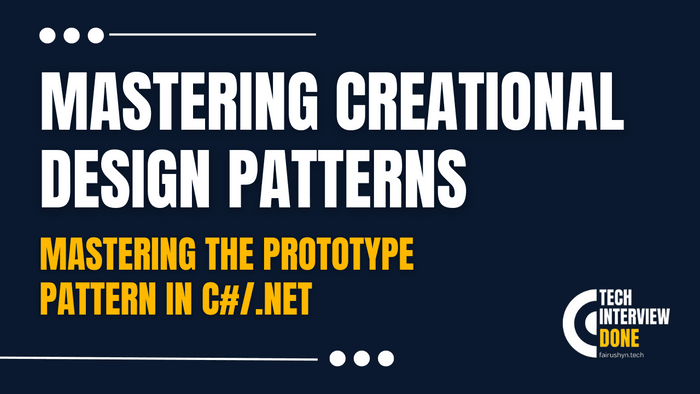Mastering the Prototype Pattern in C#/.Net
3 min read · — #design-patterns#creational-patterns#prototype
Introduction
As software complexity grows, so does the necessity for patterns that can not only reduce overhead but also enhance the adaptability and scalability of our applications. Among the plethora of design patterns, the Prototype pattern stands out for its unique approach to object creation. This pattern is particularly intriguing for software engineers looking to dive deep into the realms of efficient and dynamic instantiation mechanisms. Whether you are preparing for a technical interview or aiming to refine your design pattern repertoire, understanding the Prototype pattern in the context of C#/.Net can significantly elevate your coding toolkit.
The Prototype pattern, a member of the creational design patterns family, emphasizes the cloning of objects as opposed to creating them from scratch. This method serves a dual purpose: it bypasses the cost of new instances and provides a mechanism to copy complex objects seamlessly. Let's explore how this pattern can be applied in real-world scenarios, illustrating its potency and flexibility in solving design challenges.
Deep Dive into the Prototype Pattern
The essence of the Prototype pattern lies in its simplicity and power. It leverages an existing object to produce a new one with the same characteristics. This is particularly useful in scenarios where the creation process is resource-intensive, such as when involving database operations, file I/O, or network requests.
Implementation Basics in C#
To implement the Prototype pattern in C#, you typically start with the definition of an ICloneable interface, which
will be the cornerstone for your prototypes. However, it's important to differentiate between shallow and deep copying,
as the default implementation (MemberwiseClone()) performs a shallow copy. For many complex objects, a deep copy is
necessary to ensure that all nested objects are also cloned properly.
public interface IPrototype<T>
{
T Clone();
}Example Scenario: User Profile Cloning
Imagine a scenario in a social networking application where user profiles are complex objects that contain various details such as personal information, preferences, and friend lists. Creating a new profile for a similar user group might be resource-intensive. This is where the Prototype pattern shines.
public class UserProfile : IPrototype<UserProfile>
{
public string Name { get; set; }
public int Age { get; set; }
public List<string> Preferences { get; set; }
public UserProfile Clone()
{
// Deep copy example
return new UserProfile
{
Name = this.Name,
Age = this.Age,
Preferences = new List<string>(this.Preferences)
};
}
}This example demonstrates a deep copy mechanism where even the List<string> Preferences is cloned, ensuring that
modifications to the Preferences of the clone do not affect the original object.
Real-World Application: Template-based Document Generation
Another practical application of the Prototype pattern is in template-based document generation systems. Consider a software solution for generating reports, where each report follows a specific format but contains unique data. By using the Prototype pattern, you can clone a template report and populate it with the specific data for each case, significantly reducing the overhead of report generation.
public class ReportTemplate : IPrototype<ReportTemplate>
{
public string Header { get; set; }
public string Footer { get; set; }
public List<string> Content { get; set; }
public ReportTemplate Clone()
{
return new ReportTemplate
{
Header = this.Header,
Footer = this.Footer,
Content = new List<string>(this.Content)
};
}
}In this scenario, the Prototype pattern not only simplifies the creation process but also ensures that each report is a standalone object, reducing the risk of unintended side effects.
Conclusion
The Prototype pattern offers a versatile and efficient solution for creating objects, especially when dealing with complex or resource-intensive instantiation processes. Its implementation in C#/.Net showcases the power of object-oriented design patterns in solving real-world software design challenges. As you prepare for your technical interviews or aim to strengthen your design pattern knowledge, consider the Prototype pattern as a testament to the elegance and efficiency of modern software development practices.
